Weeton-with-Preese
Weeton-with-Preese is a civil parish in the Borough of Fylde in Lancashire, England, beside the Blackpool to Preston railway line and the M55 motorway, just east of Blackpool and 3.5 miles (5.6 km) north west of Kirkham.[1] It contains the village of Weeton.
| Weeton-with-Preese | |
|---|---|
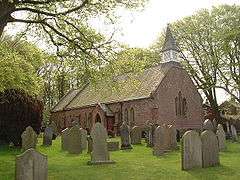 St Michael's Church | |
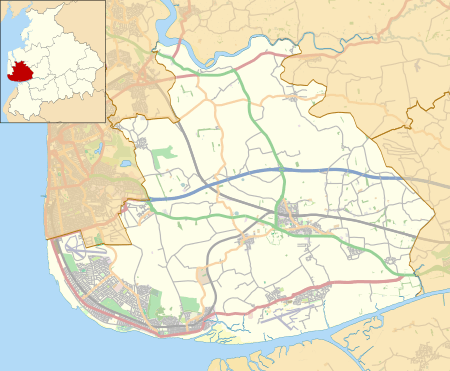 Weeton-with-Preese Shown within Fylde Borough 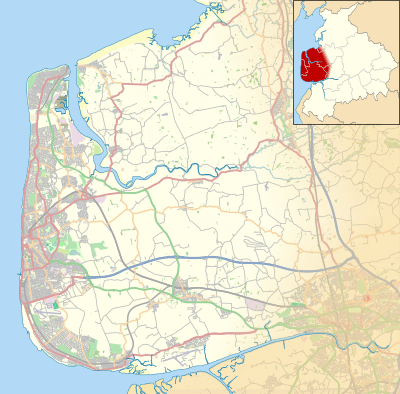 Weeton-with-Preese Shown on the Fylde 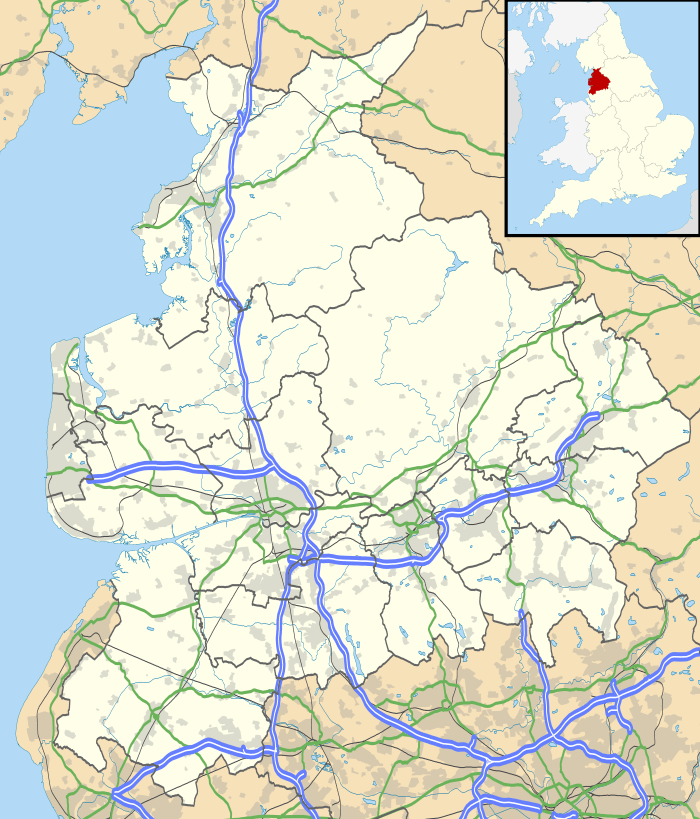 Weeton-with-Preese Location within Lancashire | |
| Population | 656 (2011) |
| OS grid reference | SD3834 |
| Civil parish |
|
| District | |
| Shire county | |
| Region | |
| Country | England |
| Sovereign state | United Kingdom |
| Post town | PRESTON |
| Postcode district | PR4 |
| Post town | BLACKPOOL |
| Postcode district | FY3, FY4 |
| Dialling code | 01253 |
| Police | Lancashire |
| Fire | Lancashire |
| Ambulance | North West |
| UK Parliament | |
Geography and administration
The area is mostly rural. Weeton is in the Fylde parliamentary constituency and the Staining and Weeton electoral ward.[2]
The parish covers an area of 2,876 acres (11.64 km2) east of Blackpool, and has a population of 1,096,[3] decreasing to 656 at the 2011 census.[4] Preese — which has recognition in the official name — has no separate measurement while Mythop (or less commonly Mythorp) has its area recorded as 677 acres (2.74 km2). Mythop, not recognised in the parish name, is divided from Weeton by mossland and the track of the Preston to Blackpool railway.
In the east, Weeton occupies most of the southern half of the parish, with Mythop in the south western corner, the northern half containing Preese on the west and Swarbrick on the east. Watson argues that these sub-manors — each with its own hall — may be based on the ancient pre-Conquest quarterland divisions characteristic of the Irish Sea cultural basin of Celtic North Wales and the Isle of Man. Each of the four manors occupies an area of slightly higher ground, each divided from the others by depressions: Weeton is 112 feet (34 m) above sea level, Swarbrick and Preese 100 feet (30 m) and Mythop 50 feet (15 m).
In an unpublished article, Watson (1994) "chases the shadows left on the ground" by suggesting that "the Manx Balla or Treen and the Welsh Tref offer a model for the Lancastrian township with its fourfold manorial division of approximately five thousand acres of land".
Although the modern day Weeton with Preese is just over half this size, Watson argues that "the documentary facts support the still discernible evidence of the quarterland skeletal frame of the townships surviving from the days of the comital estates. The evidence is further bolstered by the existence of four principal houses in most of the lowland and non-vaccary townships in the Amounderness Hundred".[5]
A road from Kirkham goes west and then north to Weeton and through Swarbrick to Singleton. From Weeton a road goes west through Mythop to Marton and Blackpool, another east to Greenhalgh and another south to Great Plumpton. The main road from Preston to Fleetwood runs north-west through the parish and the branch line to Blackpool crosses the south-west corner (cutting beneath the Mythop Road, south-east of Westfield Cottages).
History
_(remains_of).jpg)
The place-name Weeton — first recorded in the Domesday Book as Widetun — derives from the Old English wiðig (willow) and -tūn (settlement).[6] The village presumably derived its name from the presence of indigenous or farmed willows. To this day, there are fine specimens of willow trees in Weeton.
After 1066, the lordship of Weeton passed from the Northumbrian Earl Tostig to the Norman warlord Roger of Poitou. Weeton’s value at this time was assessed at "two carucates" (an area of arable land that could be worked in one day by two ploughteams).
Some time after the Domesday survey, the lordship of Weeton passed to the Butler family, early lords of Amounderness, who in 1328 became the Earls of Ormonde. the fourteenth century, the Butlers owned extensive lands, mills and fisheries in the manors of Weeton, Little Marton, Treales, Wesham, Mowbreck, Greenhalgh, Thistleton, Out Rawcliffe, Bradkirk, Medlar and Esprick.
The manors of Weeton, Preese, Mythop and Swarbrick were acquired by Sir Thomas Stanley of Lathom, later the first Earl of Derby, in 1400. They continued as part of the family estate until 1955. In the nineteenth century, the Earl of Derby commonly used the title ‘Baron of Weeton’. The title is no longer used and although there is evidence it may also have been used by Theobald Walter in the twelfth century, Weeton’s status as a barony was it seems always a matter of dispute.
By 1522, the estate had expanded to include the manors of Treales, Wesham, Out Rawcliffe, Little Marton, Greenhalgh, Plumpton and other lands. On 4 October 1637, William, 6th Earl of Derby, surrendered to James, Lord Strange, the manor of Weeton and various other ones, to enable him to make leases.
In 1670, a charter from Charles II granted Weeton an annual fair for the sale of cattle and small wares to take place on the Tuesday and Wednesday following Trinity Sunday Tolls were to be paid to the Earl of Derby and are recorded in the Bailiff ’s Accounts for the manor from 1682 (they amounted to £4 12s in that year). During the seventeenth century, a weekly fair also took place in the parish. The Trinity fair began to falter in the 1920s as local cattle-farmers sought richer markets for their stock. The fair was eventually reduced to a huddle of bring-and-buy stalls on the triangular "goose green" at the centre of the village, and was eventually replaced by the annual Gala.
The village also had a windmill, Weeton Windmill, which was built in 1812. It fell into disrepair and was demolished in the 1950s.[7]
One of the most notable local families were the Jollys of Mythop who dominated village life for more than three hundred years. Members of the family were largely responsible for the draining of Marton Mere in the eighteenth century. Their most renowned son was Edward Jolly (1664–1738) declared Master of Mythop in 1715 for his exploits in the Battle of Preston (known colloquially as the Preston Fight). The family was also related to Major James Jolly, Oliver Cromwell's Provost-Marshal General for Lancashire, and Thomas Jolly, founder of Congregationalism.[8]
Modern day village
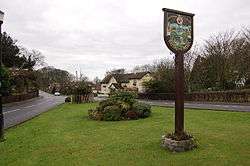
The village has one church, St. Michael's, and one primary school, Weeton St. Michael's Church of England Junior School.
The one public house in the village, the Eagle & Child, dates back to 1585 and takes its name from the family crest of local landowner Lord Derby. In front of the pub stands the old mounting steps, dating back to 1755 and the only part of the premises which are officially listed. During the years of the English Civil War Cromwell is reputed to have stayed at the premises.[9]
Each year the village hosts the Weeton Gala with a parade through the village and a garden party.[10]
In October 2007 one of the largest sales in the region for some time of Holstein cattle took place at Preese Hall Farm with the first sale to disperse the milking portion of the Loftus family’s noted old established Weeton herd.[11]
Cuadrilla Resources conducted the first hydraulic fracturing trial in the United Kingdom to produce shale gas nearby at Preese Hall, starting in 2011.[12]
A beer festival, in aid of Trinity Hospice (Blackpool) was held on 25–27 May 2012.[13]
Weeton Barracks
One mile from the village is the Weeton Barracks.[14] There was also a RAF base nearby during the World Wars. Royal Air Force Weeton continued long after the Second World War, throughout the years of National Service, until the army took over the base in the late 1950s or early 1960s. It was the RAF's MT (Motor Transport) training school for drivers and technicians—the huge Queen Mary aircraft transporters, with 'L' plates, were a common site in the lanes around Weeton.
Across the road from RAF Weeton was a separate RAF unit, RAF Hospital Weeton, main RAF Hospital for the north of England and quite autonomous from RAF Weeton—they were separate administrative and operational units. The site of the hospital is now (2014) a derelict waste ground, with just the old concrete turning circle for ambulances visible in the scrub opposite the main gate of Weeton Barracks.
The Church
The Church of St. Michael's which was founded in 1843 and has a number of historic gravestones in the graveyard, including many relating to the Jolly family.[15][16]
Notable people
- Bob Birkett - former professional footballer, born in Weeton in 1876 and spent his entire career at Blackpool F.C.
- Edward Jolly (1664-1738), Master of Mythop, hero of the 1715 Preston Rebellion
References
- "Church of St.Michael's, Weeton". GENUKI. Retrieved 29 January 2008.
- "Staining and Weeton". Fylde Borough Council. Retrieved 7 October 2010.
- Office for National Statistics : Census 2001 : Parish Headcounts : Fylde Retrieved 7 February 2010
- "Civil Parish population 2011". Retrieved 23 January 2016.
- Watson, RC (1990). "Watson of Amounderness, Lancashire: From Obscurity to Obscurity in Sixteen Generations".
- Victor Watts (ed.), The Cambridge Dictionary of English Place-Names Based on the Collections of the English Place-Name Society (Cambridge: Cambridge University Press, 2004), s.v. WEETON (1).
- "Windmills in mind". Blackpool Gazette. 6 June 2001. Retrieved 29 January 2008.
- http://www.mythop.co.uk
- "Welcome to the Eagle & Child". The Eagle & Child Pub. Retrieved 15 February 2008.
- Robinson, Joe (9 July 2007). "Weeton Gala". Blackpool Gazette. Retrieved 29 January 2008.
- Norton and Brooksbank Auctineers' Report
- Jonathan Paige (1 June 2011). "Blackpool earthquake tremors may have been caused by gas drilling". The Guardian. Retrieved 17 April 2012.
- "Weeton Beer Festival" at myfylde.co.uk
- "Weeton HIVE". Ministry of Defence. Retrieved 29 January 2008.
- "Church of St. Michael's, Weeton". GENUKI.
- "SD3834 : Church of St. Michael's, Weeton". Geograph British Isles. Retrieved 29 January 2008.
External links
![]()
.svg.png)